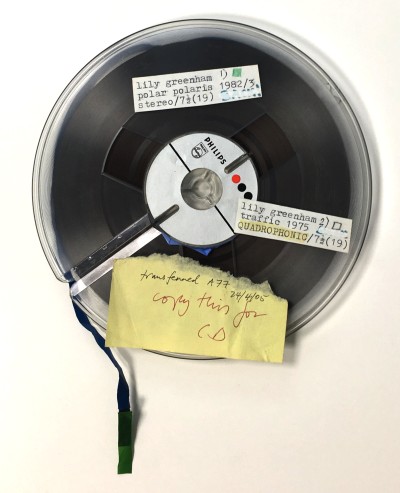during the exhibition —
LILY GREENHAM: AN ART OF LIVING
taking place
between March 8th and May 26th, 2024
at the Badischer Kunstverein, Karlsruhe.

The Badischer Kunstverein presents the extraordinary work of Lily Greenham (1924–2001) in a first major retrospective, marking the centenary of her birth. The exhibition honours the accomplishments of the artist, writer and composer and is conceived in collaboration with Goldsmiths, University of London. This project continues a series of exhibitions devoted to female artists of concrete poetry whose works have been underrepresented to date.
Lily Greenham: An Art of Living showcases Greenham’s pioneering works in the area of sound poetry and lingual music, alongside her works of op, kinetic and computer art, which are represented in international collections. The exhibition focuses on the radical nature of Greenham’s polyphonic, polylingual, multinational, and feminist works. Greenham’s restless shifts between diverse places, languages, and disciplines are closely bound up with her biography, which gave rise to her continual receptivity – even early on – to new phenomena, languages, and contexts. She consistently interrogated what it means to communicate as an artist: she explored these multiple dimensions across different art forms. Greenham’s play with language and identity led to the cultivation of a truly unique artistic practice, encompassing etchings, collages, poems, texts and computer graphics, along with a large archive of sound works.
Lily Greenham’s artistic practice embodies principles of movement and change: she forwarded work that refuses to be static and bounded, work that continually alters perspective, whether in the displacement between colour and light in her widely known light boxes, the shifting geometric patterns of her collages, or the phase and panning techniques of her sound works. Across her practice, Greenham deployed central concepts such as notation, variation, repetition, and rhythm. Her vibrant exposition of lingual music and sound poetry threaded throughout her life, and the exhibition at the Kunstverein highlights her performances and electroacoustic compositions, which she began in the late 1960s.
Opening with the sound work Outsider (1970), the exhibition at the Kunstverein unfolds an overview of Greenham’s life and poesis, from her involvement with the Wiener Gruppe in the 1950s, with correspondence, scores and performances of works by Gerhard Rühm, and Ernst Jandl, to her association with the Nouvelle Tendence and GRAV (Groupe de Recherche d'Art Visuel) groups in Paris in the 1960s, where she began creating a number of reknowned kinetic light objects and op art collages, a series of which are on show in the exhibition.
Speaking and performing in eight languages, Greenham developed the term lingual music in the 1970s, whose ground-breaking voice-based studio techniques have gone on to influence subsequent generations of experimental musicians. With lingual music, Greenham deployed her voice as a radical sonic resource on reel-to-reel tape: letters, syllables, words and sentences are distended, superimposed, repeated, and reinterpreted. Pioneering sound works featured throughout the exhibition include the award-winning Relativity (1974), recorded at the BBC Radiophonic Workshop, and Traffic (1975), made at the Electronic Music Studios at Goldsmiths, University of London. In Circulation (1975/76), a French-language version of Traffic, Greenham used the sampler on a PDP-8 computer, long before commercial audio samplers existed. In the 1980s, Greenham created a series of early computer art works entitled Homecomputer Graphics, shown for the first time. A compilation of filmic works, installed at various moments in the exhibition, portray her collaborations with artist filmmakers including Lis Rhodes and Jo Davis (on the film series Hang On A Minute (1983)), Ed and Irm Sommer (on the films Gesichter (1972) and Body Poem (1970)), and Carola Klein (on the film Mirror Phase (1978), working together with Michael Parsons).
One of the few women in the worlds of art and music in the 1960s and 70s, then largely dominated by men, Greenham considered herself an outsider and refused to be restrained by conventions. Her artistic praxis embodies an openness to experience, a rejection of normative structures, of existing outside of society and nationality. This is succinctly conveyed in Greenham’s contribution to Herbert Distel’s Schubladenmuseum / Museum of Drawers (1970), a note bearing the words: ‘sorry! lily greenham cannot be pigeon-holed’. Greenham once described her situation by stating: ‘Categories don’t fit my character, nor my soul. I am a stranger in a strange land.’1 This exhibition, and its accompanying programme demonstrates the uniquely multifaceted character of her oeuvre. Each section of the show is accompanied by numerous contextual photographs, letters, and notations from the Lily Greenham Archive in London, which is being presented to the public for the very first time. This project was preceded by a detailed five-year research process undertaken by the London curators, and a sustained collaboration with researchers at Goldsmiths, University of London, which has provided access to a large body of new material surrounding Greenham’s work and life. Lily Greenham: An Art of Living will be accompanied by a two-day symposium (May 3/4, 2024), as well as a website and print publication.
Curated by James Bulley, Andrew Walsh-Lister, Anja Casser & Alex Balgiu. Consultant research and sound archiving by Ian Stonehouse.
In cooperation with Goldsmiths, University of London & Bricks from the Kiln. With thanks to Michael Parsons.
Funded by the Kulturstiftung des Bundes (German Federal Cultural Foundation) & Beauftragte der Bundesregierung für Kultur und Medien (Federal Government Commissioner for Culture and the Media).


